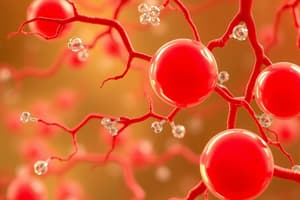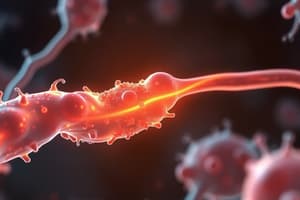Podcast
Questions and Answers
What is the end product of glycolysis?
What is the end product of glycolysis?
- Glucose
- Acetyl-CoA
- NADH
- Pyruvate (correct)
How many ATP molecules are produced during the glycolysis process?
How many ATP molecules are produced during the glycolysis process?
- None
- Two (correct)
- Four
- One
Which enzyme catalyzes the conversion of phosphoenolpyruvate to pyruvate?
Which enzyme catalyzes the conversion of phosphoenolpyruvate to pyruvate?
- Glucokinase
- Pyruvate kinase (correct)
- Phosphoglycerate mutase
- Hexokinase
What role does lactate dehydrogenase play in glycolysis when oxygen is scarce?
What role does lactate dehydrogenase play in glycolysis when oxygen is scarce?
What is produced from the conversion of 1,3-bisphosphoglycerate to 3-phosphoglycerate?
What is produced from the conversion of 1,3-bisphosphoglycerate to 3-phosphoglycerate?
What is the significance of the term 'bisphosphate' in biochemical terms?
What is the significance of the term 'bisphosphate' in biochemical terms?
Which GLUT transporter is associated with glucose transport in the liver?
Which GLUT transporter is associated with glucose transport in the liver?
What can high levels of lactate dehydrogenase in the blood indicate?
What can high levels of lactate dehydrogenase in the blood indicate?
What type of transporter is responsible for the movement of glucose across cell membranes?
What type of transporter is responsible for the movement of glucose across cell membranes?
Which GLUT transporter is primarily found in muscle and adipose tissue and is regulated by insulin?
Which GLUT transporter is primarily found in muscle and adipose tissue and is regulated by insulin?
What molecule is created when glucose is phosphorylated by hexokinase or glucokinase?
What molecule is created when glucose is phosphorylated by hexokinase or glucokinase?
Which enzyme is responsible for the conversion of glucose-6-phosphate to fructose-6-phosphate?
Which enzyme is responsible for the conversion of glucose-6-phosphate to fructose-6-phosphate?
What energy molecule is used in the phosphorylation of fructose-6-phosphate to create fructose-1,6-bisphosphate?
What energy molecule is used in the phosphorylation of fructose-6-phosphate to create fructose-1,6-bisphosphate?
What are the two three-carbon molecules generated from the cleavage of fructose-1,6-bisphosphate?
What are the two three-carbon molecules generated from the cleavage of fructose-1,6-bisphosphate?
What is the product of the oxidation and phosphorylation of GA3P by glyceraldehyde-3-phosphate dehydrogenase?
What is the product of the oxidation and phosphorylation of GA3P by glyceraldehyde-3-phosphate dehydrogenase?
Which enzyme is responsible for converting fructose-6-phosphate to fructose-1,6-bisphosphate?
Which enzyme is responsible for converting fructose-6-phosphate to fructose-1,6-bisphosphate?
Flashcards
Glycolysis
Glycolysis
A metabolic pathway that breaks down glucose into pyruvate in the cytoplasm, producing a net gain of 2 ATP and 2 NADH.
Glucose
Glucose
The starting molecule (substrate) of glycolysis.
Pyruvate
Pyruvate
The end product of glycolysis.
ATP
ATP
Signup and view all the flashcards
NADH
NADH
Signup and view all the flashcards
Kinase
Kinase
Signup and view all the flashcards
Pyruvate Kinase
Pyruvate Kinase
Signup and view all the flashcards
Lactate Dehydrogenase
Lactate Dehydrogenase
Signup and view all the flashcards
Glucose Transport
Glucose Transport
Signup and view all the flashcards
GLUT Transporters
GLUT Transporters
Signup and view all the flashcards
GLUT 1
GLUT 1
Signup and view all the flashcards
GLUT 4
GLUT 4
Signup and view all the flashcards
Phosphorylation of Glucose
Phosphorylation of Glucose
Signup and view all the flashcards
Irreversible Step in Glycolysis
Irreversible Step in Glycolysis
Signup and view all the flashcards
Glyceraldehyde-3-Phosphate (GA3P)
Glyceraldehyde-3-Phosphate (GA3P)
Signup and view all the flashcards
Study Notes
Glucose Transport
- Glucose is a six-carbon monosaccharide.
- Glucose is a water-soluble solute; it cannot passively diffuse through the cell membrane.
- Specialized transporters called GLUT transporters facilitate glucose movement across cell membranes.
- GLUT transporters are bidirectional, meaning they can transport glucose both into and out of cells.
- There are different types of GLUT transporters that are prevalent in different organs, each with specific functions.
Glut Transporter Types and Locations
- GLUT 1: found in red blood cells, the fetus, and the blood-brain barrier.
- GLUT 2: found in the kidney, liver, pancreas, and the gastrointestinal tract.
- GLUT 3: found in the placenta, neurons, and the kidney.
- GLUT 4: found in muscle and adipose (fat) tissue. GLUT 4 is insulin-dependent; its activity is regulated by insulin levels.
Phosphorylation and Glycolysis
- Once glucose enters the cell, it is phosphorylated on the sixth carbon by the enzyme hexokinase or glucokinase, creating glucose-6-phosphate.
- Hexokinase is found in various tissues, including muscle.
- Glucokinase is primarily found in the liver and is sometimes referred to as hexokinase type 4.
- The phosphate for phosphorylation comes from ATP, which is converted to ADP.
Isomerization and Fructose-6-Phosphate
- Glucose-6-phosphate is isomerized (structural change) to fructose-6-phosphate by the enzyme phosphohexose isomerase.
- Isomerization is a reversible step.
Phosphorylation and Fructose-1,6-bisphosphate
- Fructose-6-phosphate is then phosphorylated on the first carbon by the enzyme phosphofructokinase 1 (PFK1), creating fructose-1,6-bisphosphate.
- This is an irreversible step and a major regulatory point in glycolysis.
- Another ATP molecule is used in this step, converting to ADP.
Cleavage and Glyceraldehyde-3-Phosphate
- Fructose-1,6-bisphosphate is then cleaved into two three-carbon molecules: dihydroxyacetone phosphate (DHAP) and glyceraldehyde-3-phosphate (GA3P) by the enzyme aldolase.
- Most of the DHAP is converted to GA3P by the enzyme triose phosphate isomerase, ensuring efficient glycolysis.
Oxidation and 1,3-bisphosphoglycerate
- GA3P is then oxidized and phosphorylated by the enzyme glyceraldehyde-3-phosphate dehydrogenase, generating 1,3-bisphosphoglycerate.
- This step involves the reduction of NAD+ to NADH, and the enzyme also adds an inorganic phosphate.
- Since two GA3P molecules are generated initially, two NADH molecules are produced.
ATP Generation and 3-phosphoglycerate
- 1,3-bisphosphoglycerate is converted to 3-phosphoglycerate by the enzyme phosphoglycerate kinase.
- This step generates ATP, with one ATP molecule generated per 1,3-bisphosphoglycerate molecule, meaning two ATP molecules are produced.
Additional Notes
- The mnemonic "Be Be Be, Ok Kids Lips Are But This Doesn't Matter, Ok Pink Mother-Father" can be used to remember different GLUT transporters and their locations.
- The mnemonic "DHAP" can help you remember the first three carbons in the molecule dihydroxyacetone phosphate.
- The term "bisphosphate" indicates that the phosphate groups are separated by at least one carbon atom in the molecule.
Glycolysis
- Glycolysis is a metabolic pathway that occurs in the cytoplasm of cells and involves the breakdown of glucose into pyruvate.
- The starting molecule, or substrate, of glycolysis is glucose.
- The end product of glycolysis is two pyruvate molecules.
- Glycolysis results in a net gain of two ATP molecules, as two ATP are consumed in the initial steps and four ATP are produced.
- In glycolysis, two molecules of NADH are generated.
- Glycolysis is typically an anaerobic process, meaning it occurs in the absence or low levels of oxygen.
- When oxygen is scarce, NADH is converted back to NAD+ by reducing pyruvate to lactate.
- Lactate dehydrogenase is an enzyme that catalyzes this conversion of pyruvate to lactate.
- High levels of lactate dehydrogenase in the blood may indicate conditions such as myocardial infarction, necrotic bowel, or ischemia, which can decrease oxygen supply to tissues and drive lactate production to compensate.
- Lactic acid production can lead to metabolic acidosis, lowering blood pH.
- This can contribute to an anion gap, which can be observed in blood tests.
Other Key Enzymes in Glycolysis
- Kinase: Enzymes that phosphorylate substrates using ATP.
- Glucokinase: Participates in the initial phosphorylation of glucose, converting it into glucose-6-phosphate.
- Hexokinase: Also involved in glucose phosphorylation.
- Pyruvate kinase: Catalyzes the conversion of phosphoenolpyruvate to pyruvate, generating ATP.
- Phosphoglycerate mutase: Facilitates the transfer of a phosphate group from the 3rd carbon to the 2nd carbon of glycerate.
- Enolase: Converts 2-phosphoglycerate into phosphoenolpyruvate.
Studying That Suits You
Use AI to generate personalized quizzes and flashcards to suit your learning preferences.




